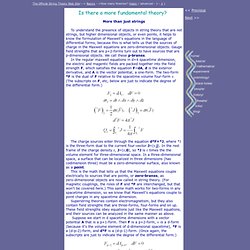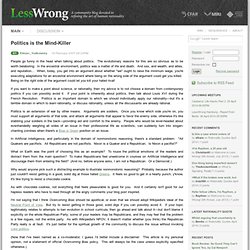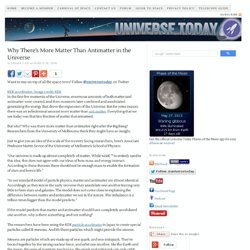

Jobs. Scientists discover how to turn light into matter after 80-year quest. Imperial College London physicists have discovered how to create matter from light -- a feat thought impossible when the idea was first theorised 80 years ago.

In just one day over several cups of coffee in a tiny office in Imperial's Blackett Physics Laboratory, three physicists worked out a relatively simple way to physically prove a theory first devised by scientists Breit and Wheeler in 1934. Breit and Wheeler suggested that it should be possible to turn light into matter by smashing together only two particles of light (photons), to create an electron and a positron -- the simplest method of turning light into matter ever predicted.
How many theories? More than just strings To understand the presence of objects in string theory that are not strings, but higher dimensional objects, or even points, it helps to know the formulation of Maxwell's equations in the language of differential forms, because this is what tells us that the sources of charge in the Maxwell equations are zero-dimensional objects.

Gauge field strengths that are p+2-forms turn out to have sources that are p-dimensional objects. We call these p-branes. Craig A. Blocker. Professor of Physics Ph.D., University of California, Berkeley, 1980 Craig Blocker is a member of the experimental high energy physics group at Brandeis.

This group is currently collaborating on the ATLAS experiment at the Large Hadron Collider (LHC) at CERN in Geneva, Switzerland. In the LHC, protons collide with protons at 8 TeV in the center of mass, the world’s highest energy particle collisions. Professor Blocker is particularly interested in several of the very exciting physics possibilities at the LHC, including the Higgs boson, lepton flavor violation, supersymmetry, excited leptons, left-right symmetric models, and potential extra spatial dimensions.
CV and complete list of publications Recent Ph.D. Andy Foland's Cloud Chamber Page. : Dry ice and isopropanol can be dangerous!

What you will need to build the chamber: A clear, see-through container with an open top, about 6" by 12", and about 6" high. Make sure it is boxlike with flat sides, rather than being round. How can I make a particle accelerator? Www.tularehhsa.org/?LinkServID=0270C6A6-F1F6-BDD5-87E743BDB42D0D59&showMeta=0. DIY Electron Accelerator: A Cathode Ray Tube in a Wine Bottle.
As complex as the idea of a particle accelerator might seem, it's actually strikingly simple to implement.

How much a crt computor monitor cost.? Politics is the Mind-Killer. People go funny in the head when talking about politics.

The evolutionary reasons for this are so obvious as to be worth belaboring: In the ancestral environment, politics was a matter of life and death. And sex, and wealth, and allies, and reputation... When, today, you get into an argument about whether "we" ought to raise the minimum wage, you're executing adaptations for an ancestral environment where being on the wrong side of the argument could get you killed. Being on the right side of the argument could let you kill your hated rival!
If you want to make a point about science, or rationality, then my advice is to not choose a domain from contemporary politics if you can possibly avoid it. Politics is an extension of war by other means. The difference between "centripetal" and "centrifugal" force. This one's in response to another high-school student's question: What's the difference between "centripetal" and "centrifugal" force?

Why do we say this has something to do with relativity? Well, defining centripetal force is easy. Centripetal force is what keeps pulling a rotating object towards the center of what it's rotating around so that it doesn't fly away. NASA's Chandra Observatory catches giant black hole rejecting material. Astronomers using NASA's Chandra X-ray Observatory have taken a major step in explaining why material around the giant black hole at the center of the Milky Way Galaxy is extraordinarily faint in X-rays.

This discovery holds important implications for understanding black holes. Astronomic news: the universe may not be expanding after all. Experiments. LHC experiments Seven experiments at the Large Hadron Collider (LHC) use detectors to analyse the myriad of particles produced by collisions in the accelerator.

Quantum Mechanics. String Theory. Why There’s More Matter Than Antimatter in the Universe. Want to stay on top of all the space news?

Follow @universetoday on Twitter In the first few moments of the Universe, enormous amounts of both matter and antimatter were created, and then moments later combined and annihilated generating the energy that drove the expansion of the Universe. But for some reason, there was an infinitesimal amount more matter than anti matter . Everything that we see today was that tiny fraction of matter that remained. But why? “Our universe is made up almost completely of matter. “In our standard model of particle physics, matter and antimatter are almost identical. Herschel Space Observatory Finds Galaxy Mega Merger. Several telescopes have teamed up to discover a rare and massive merging of two galaxies that took place when the universe was just 3 billion years old (its current age is about 14 billion years).
Pulsar Myth : Fractal Universe. Currently accepted pulsar theory has too many self-contradictions: Some free protons and electrons are assumed to remain inexplicably at the star’s surface, immune to intense gravity, whilst the rest succumb to being squashed into neutrons. This “atmosphere” of particles is assumed to cut the star’s rotating magnetic field to generate the current necessary for the production of radio energy. Antimatter might fall up, but it won't blow up the world. This illustration shows what might happen when matter and antimatter annihilate each other. Scientists have long hypothesized that the Big Bang produced lots of antimatter It no longer exists in nature, physicists say It is produced on Earth in particle accelerators Physicists study it to learn more about the formation of the universe (CNN) -- Nuclear scientists in Switzerland recently dropped some antimatter.
The world didn't blow up, but there were some tiny explosions. Scientists are hoping the experiment will teach them more about how the universe developed after the Big Bang. Positron emission tomography. PET/CT-System with 16-slice CT; the ceiling mounted device is an injection pump for CT contrast agent Whole-body PET scan using 18F-FDG Positron emission tomography (PET)[1] is a nuclear medicine, functional imaging technique that produces a three-dimensional image of functional processes in the body. Magnetar. Artist's conception of a magnetar, with magnetic field lines. Description[edit] Like other neutron stars, magnetars are around 20 kilometres (10 mi) in diameter and have a greater mass than the Sun. The density of the interior of a magnetar is such that a thimble full of its substance would have a mass of over 100 million tons.[1] Magnetars are differentiated from other neutron stars by having even stronger magnetic fields, and rotating comparatively slowly, with most magnetars completing a rotation once every one to ten seconds,[7] compared to less than one second for a typical neutron star.
This magnetic field gives rise to very strong and characteristic bursts of X-rays and gamma rays.